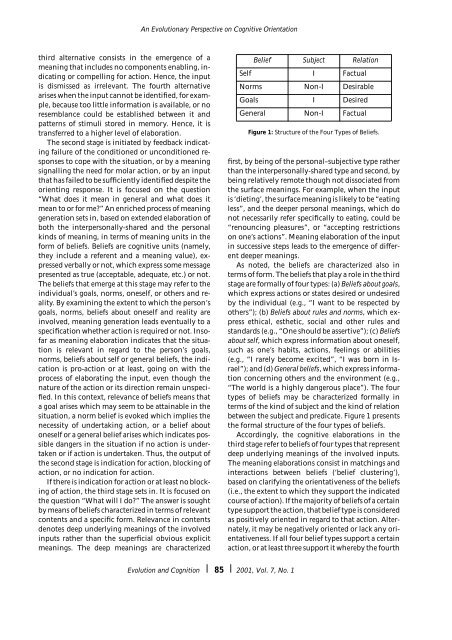The Seven Sins of Evolutionary Psychology - Konrad Lorenz Institute
The Seven Sins of Evolutionary Psychology - Konrad Lorenz Institute
The Seven Sins of Evolutionary Psychology - Konrad Lorenz Institute
You also want an ePaper? Increase the reach of your titles
YUMPU automatically turns print PDFs into web optimized ePapers that Google loves.
An <strong>Evolutionary</strong> Perspective on Cognitive Orientationthird alternative consists in the emergence <strong>of</strong> ameaning that includes no components enabling, indicatingor compelling for action. Hence, the inputis dismissed as irrelevant. <strong>The</strong> fourth alternativearises when the input cannot be identified, for example,because too little information is available, or noresemblance could be established between it andpatterns <strong>of</strong> stimuli stored in memory. Hence, it istransferred to a higher level <strong>of</strong> elaboration.<strong>The</strong> second stage is initiated by feedback indicatingfailure <strong>of</strong> the conditioned or unconditioned responsesto cope with the situation, or by a meaningsignalling the need for molar action, or by an inputthat has failed to be sufficiently identified despite theorienting response. It is focused on the question“What does it mean in general and what does itmean to or for me?” An enriched process <strong>of</strong> meaninggeneration sets in, based on extended elaboration <strong>of</strong>both the interpersonally-shared and the personalkinds <strong>of</strong> meaning, in terms <strong>of</strong> meaning units in theform <strong>of</strong> beliefs. Beliefs are cognitive units (namely,they include a referent and a meaning value), expressedverbally or not, which express some messagepresented as true (acceptable, adequate, etc.) or not.<strong>The</strong> beliefs that emerge at this stage may refer to theindividual’s goals, norms, oneself, or others and reality.By examining the extent to which the person’sgoals, norms, beliefs about oneself and reality areinvolved, meaning generation leads eventually to aspecification whether action is required or not. Ins<strong>of</strong>aras meaning elaboration indicates that the situationis relevant in regard to the person’s goals,norms, beliefs about self or general beliefs, the indicationis pro-action or at least, going on with theprocess <strong>of</strong> elaborating the input, even though thenature <strong>of</strong> the action or its direction remain unspecified.In this context, relevance <strong>of</strong> beliefs means thata goal arises which may seem to be attainable in thesituation, a norm belief is evoked which implies thenecessity <strong>of</strong> undertaking action, or a belief aboutoneself or a general belief arises which indicates possibledangers in the situation if no action is undertakenor if action is undertaken. Thus, the output <strong>of</strong>the second stage is indication for action, blocking <strong>of</strong>action, or no indication for action.If there is indication for action or at least no blocking<strong>of</strong> action, the third stage sets in. It is focused onthe question “What will I do?” <strong>The</strong> answer is soughtby means <strong>of</strong> beliefs characterized in terms <strong>of</strong> relevantcontents and a specific form. Relevance in contentsdenotes deep underlying meanings <strong>of</strong> the involvedinputs rather than the superficial obvious explicitmeanings. <strong>The</strong> deep meanings are characterizedBelief Subject RelationSelf I FactualNorms Non-I DesirableGoals I DesiredGeneral Non-I FactualFigure 1: Structure <strong>of</strong> the Four Types <strong>of</strong> Beliefs.first, by being <strong>of</strong> the personal–subjective type ratherthan the interpersonally-shared type and second, bybeing relatively remote though not dissociated fromthe surface meanings. For example, when the inputis ‘dieting’, the surface meaning is likely to be “eatingless”, and the deeper personal meanings, which donot necessarily refer specifically to eating, could be“renouncing pleasures”, or “accepting restrictionson one’s actions”. Meaning elaboration <strong>of</strong> the inputin successive steps leads to the emergence <strong>of</strong> differentdeeper meanings.As noted, the beliefs are characterized also interms <strong>of</strong> form. <strong>The</strong> beliefs that play a role in the thirdstage are formally <strong>of</strong> four types: (a) Beliefs about goals,which express actions or states desired or undesiredby the individual (e.g., “I want to be respected byothers”); (b) Beliefs about rules and norms, which expressethical, esthetic, social and other rules andstandards (e.g., “One should be assertive”); (c) Beliefsabout self, which express information about oneself,such as one’s habits, actions, feelings or abilities(e.g., “I rarely become excited”, “I was born in Israel”);and (d) General beliefs, which express informationconcerning others and the environment (e.g.,“<strong>The</strong> world is a highly dangerous place”). <strong>The</strong> fourtypes <strong>of</strong> beliefs may be characterized formally interms <strong>of</strong> the kind <strong>of</strong> subject and the kind <strong>of</strong> relationbetween the subject and predicate. Figure 1 presentsthe formal structure <strong>of</strong> the four types <strong>of</strong> beliefs.Accordingly, the cognitive elaborations in thethird stage refer to beliefs <strong>of</strong> four types that representdeep underlying meanings <strong>of</strong> the involved inputs.<strong>The</strong> meaning elaborations consist in matchings andinteractions between beliefs (‘belief clustering’),based on clarifying the orientativeness <strong>of</strong> the beliefs(i.e., the extent to which they support the indicatedcourse <strong>of</strong> action). If the majority <strong>of</strong> beliefs <strong>of</strong> a certaintype support the action, that belief type is consideredas positively oriented in regard to that action. Alternately,it may be negatively oriented or lack any orientativeness.If all four belief types support a certainaction, or at least three support it whereby the fourthEvolution and Cognition ❘ 85 ❘ 2001, Vol. 7, No. 1








